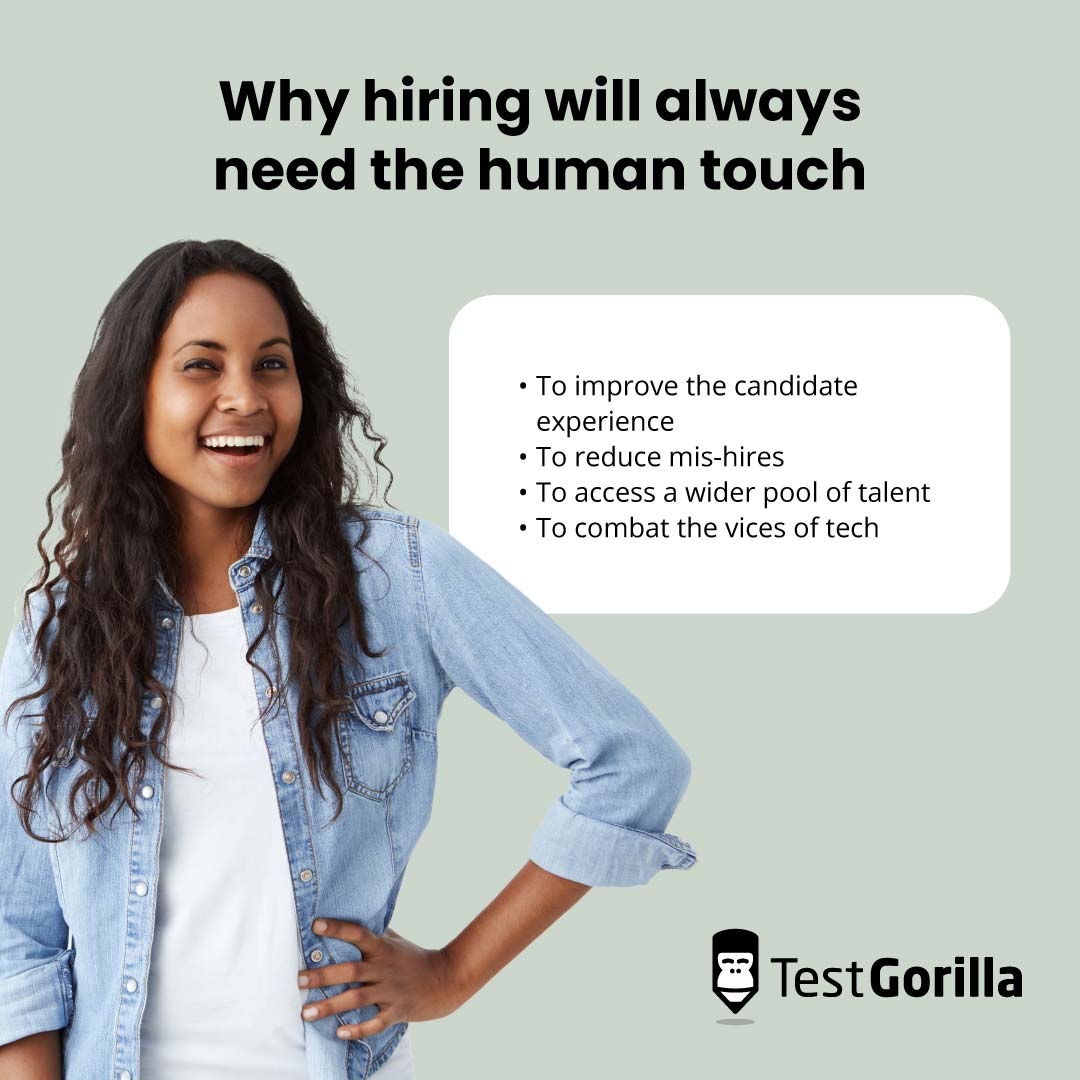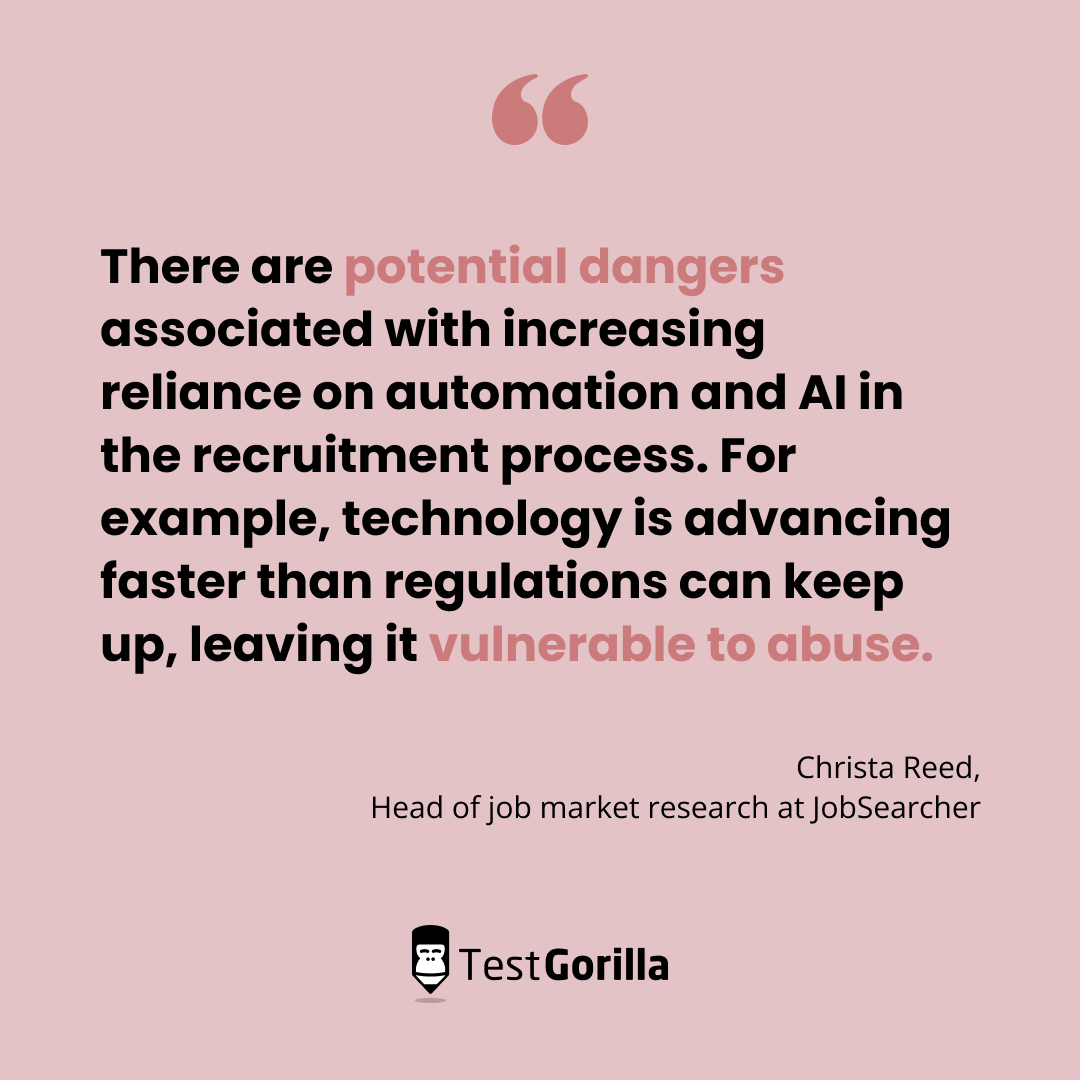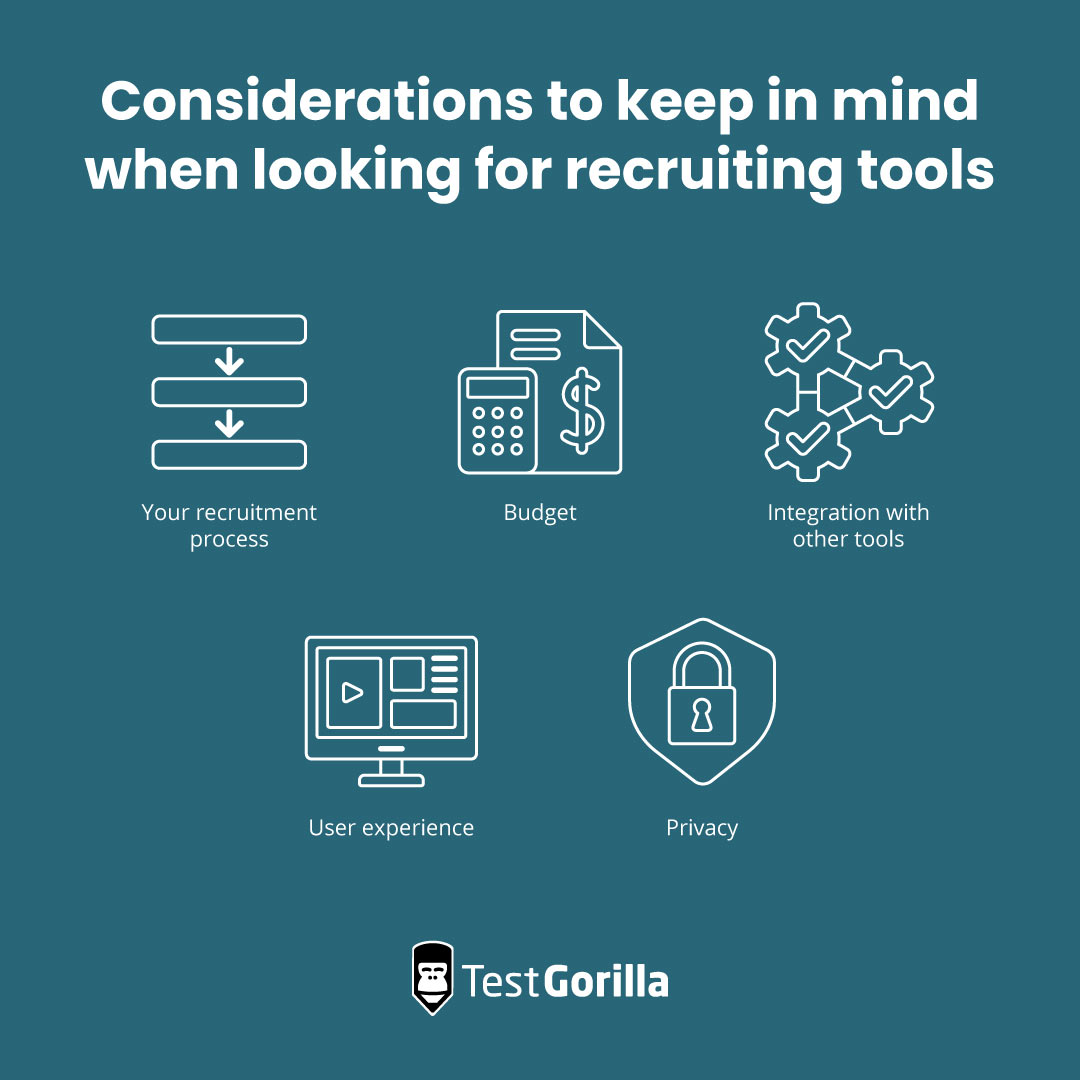With great power comes great responsibility: How to automate recruitment wisely
If you’ve followed the recent ChatGPT phenomena (and, if not, where have you been?), you’ll know AI is only getting smarter and better.
But, while bots excel at tasks like sourcing, sorting, and compiling huge amounts of data, they still have their limitations – including the possibility of baked-in algorithmic bias. That means they’re not always the best choice for selecting candidates for your open roles.
Humans still need to lean into what we do best: Creating, innovating, and understanding personal experiences. And when it comes to recruitment, you need to strike the right balance between leveraging recruiting automation tools and human skills. This will let you focus on high-value tasks that only humans can do, like improving the candidate experience.
In this article, we’ll walk you through recruiting automation, what’s driving companies to adopt it, and why it’ll always need a human touch. We’ll also explain how to get automation right so you can use it to win, rather than drive away, top talent.
The current state of recruiting automation
Plenty of companies use recruiting automation to manage, automate, and streamline aspects of the recruitment process such as, job posting, resume screening, interview scheduling, and candidate engagement.
Some popular recruiting automation tools include:
Applicant tracking systems (ATS): To automate resume and cover letter screening
Recruiting automation platforms: To automatically source candidates, schedule interviews, and communicate with candidates using chatbots
Talent acquisition platforms: To automatically source, screen, schedule, and engage with candidates
It’s important not to confuse these recruitment tools with AI. Although recruiting automation might use AI, automation tools process data differently.
Automation tools work with data without trying to interpret it. For example, a tool might quickly pull data from varied sources for faster, more effective research. There’s no chance of misinterpretation; it’s just a shortcut. By contrast, AI interacts with data to understand and learn from it like a human would, which means it can make mistakes.
While AI might aim to imitate human intelligence, automation frees up people to do more of what they do best.
The TestGorilla platform, for example, uses recruiting automation to screen and analyze candidates’ skills-based test results. It automates the scoring and ranking of tests so that you don’t have to.
You can see how recruiting automation is useful, but let’s dig deeper into why it’s so popular right now and what’s its driving adoption.
What’s driving the adoption of recruiting automation?
The use of recruiting automation like resume screening tools is on the rise. In fact, one in four companies uses recruiting automation and/or AI to support HR activities like recruitment and performance management. Talent professionals claim automation is the top trend impacting how they hire.
There are a few reasons for this:
Availability of advanced tech. Artificial intelligence, machine learning, and other advanced technologies have made it easier for companies to automate many aspects of the recruiting process. These technologies can help to improve the accuracy of candidate screening, provide more personalized communication, and offer better data analysis and reporting. Also, to focus on higher-level tasks like improving the candidate experience.
The talent war. In a competitive job market, time-to-hire is a critical metric. The longer a job opening goes unfilled, the more opportunity there is for other companies to snatch up top talent. Recruitment automation can speed up the hiring process by automating administrative and data analysis tasks and making sure you get in front of in-demand candidates by quickly scheduling interviews and sending timely follow-up emails.
The nature of modern work. With the rise of remote work and occupational mobility, recruiting automation has made it possible for companies to hire beyond their doorstep and better manage candidate data.
Because of these reasons, says Kelly Robinson, chief executive officer and founder of PKRecruiting, companies are using AI and recruiting automation to “fast-forward the hiring process.”
It makes sense for some companies, specifically larger corporations, to use recruiting automation because it saves tons of time and resources. In fact, the average staffing firm currently automates over 20,000 tasks, emails, texts, updates, and notes per recruiter each year. That’s 2.5 million employee hours saved in 2021 alone – or three hours every day per recruiter.
To make the most of these benefits, you need to know how to use automation in the right way, for the right tasks, at the right time, and as a complement to human activities.
The best insights on HR and recruitment, delivered to your inbox.
Biweekly updates. No spam. Unsubscribe any time.
Why hiring will always need the human touch
Recruiting automation saves costs, increases efficiency, and improves the candidate experience with consistent automated communication and updates. But it can also be risky to rely on it.
Around 79% of recruiters believe that people won’t need to be involved in the recruitment process in the near future. By contrast, 56% of candidates feel that the final hiring decision should always be made by humans. Clearly, there’s a disconnect between how recruiters and candidates view the role of automation and AI in the candidate experience.
Kelly believes employee engagement relies on the candidate experience and slowing down – not speeding up – certain aspects of the hiring process. “You still need to meet with people, talk to them, spend time building relationships, and find out what makes them tick.”
Here’s why:
To improve the candidate experience
Recruitment isn’t just about finding the right candidate for the job — it’s also about building a relationship with them.
Human touches like sending personalized messages and providing feedback and support throughout the hiring process help create an emotional connection with candidates. They also make them feel more invested in the recruitment process and more likely to accept your job offer.
For example, automated, one-size-fits-all messages can sometimes be confusing or unclear. But a human recruiter can provide more context and explanation to make sure candidates understand what’s happening at each stage and what’s expected of them.
This is important because it means you’re more likely to hire the right person for the position and reduce costly mis-hires, total cost-to-hire, and employee turnover. It’s also better for rejected candidates as they can understand exactly why they didn’t make the cut.
To reduce mis-hires
Recruiters using automation fill 64% more job vacancies. But simply finding people to fill an open role doesn’t mean they’re the right person for it, or that they’ll stay.
And according to our State of Skills-Based Hiring report, the cost of a mis-hire is 24 times an employee’s annual salary — which could mean a serious drain on resources for your organization.
Even when hiring remotely, you need to meet candidates “face-to-face” for a more context-driven evaluation and nuanced approach. While recruitment tools can help you evaluate a candidate’s hard and soft skills, meetings and conversations can complement the information you get from those.
On top of soft or transferable skills, you also need to get a feel for your candidates as people, and they need to assess if they’ll actually like the day-to-day responsibilities of the job. You can use pre-employment assessments for this: A skills test will give your candidates a feel for what they’ll be doing if they’re successful.
To access a wider pool of talent
To attract and appeal as much talent as possible, you need to keep Gen Z top of mind. Research shows they want more transparency during recruitment and prioritize work-life balance over salary and benefits.
“The lack of transparency in how AI and automation are used in the recruitment process makes it difficult for candidates to understand the process and selection, which results in a limited talent pool.” LynnAnn Brewer, director of HR research and advisory services at McLean & Company.
Instead of being another cog in the machine, Gen Z candidates want to form personal connections with recruiters. This means you need to personalize the recruitment process by sending customized messages, tailoring the selection process to the candidate’s skills and those required for the role, and providing timely feedback throughout. Avoid sending an automated email to each candidate or giving little more than a vague hiring timeline.
To combat the vices of tech
AI reflects the worldview and experience of its programmers. This means it can inadvertently be programmed with preferences that favor certain groups of applicants and perpetuate bias.
“There are potential dangers associated with increasing reliance on automation and AI in the recruitment process,” says Christa Reed, head of job market research at JobSearcher. “For example, technology is advancing faster than regulations can keep up, leaving it vulnerable to abuse. Automated tools could also pose a risk of bias when making decisions, as algorithms may be built on historical data that includes existing biases.”
For example, Amazon’s AI recruiting tool learned to favor men and discriminate against mentions of the word “women’s” on resumes. It was trained to vet resumes by observing patterns in successful resumes over 10 years, most of which came from men, so it unfairly penalized female applicants.
You need to oversee automation technology and check results to help reduce bias. And take into account the individual circumstances of each candidate, and use standardized evaluation criteria that aren’t influenced by demographic factors.
How to get recruiting automation right
As we’ve seen, relying solely on automation or using it to cut out essential parts of your hiring process can significantly limit you by narrowing your candidate pool and negatively impacting their experience.
Here’s how to do recruiting automation right.
Adopt skills-based hiring
Skills-based hiring is an emerging approach to hiring that focuses on a candidate’s skills and applied knowledge rather than their resume, connections, and qualifications. This helps level the playing field for diverse candidates by stripping the hiring process of human and algorithmic bias.
Of the companies using skills-based hiring that we surveyed in our report, 92.5% saw a reduction in total mis-hires, 91.4% reduced time-to-hire, and 91.2% saw an increase in employee retention. Their employees are better matched to their roles, are happier, and stay longer.
In the wake of ChatGPT, you never know which candidates are using AI to beef up their resumes and cover letters. Which means investing in yet another tool to run full-scale plagiarism checks.
But you can’t fake skills.
By focusing on skills-based assessments and tests over ATSs with resume keyword bias, you get people with the right soft and hard skills. You can still automate repetitive tasks like administering and assessing tests, so you get to weed out applicants with the wrong or misaligned skills early on. This saves your precious time for when it matters most – during face-to-face interviews with your candidates.
Choose the right tools for the job
As a hiring manager, you need to understand which types of tasks you want to automate and then look for the right tools to help you.
Here are some considerations to keep in mind when looking for recruiting tools:
Your recruitment process. Consider the stages of your hiring process, from sourcing applicants to onboarding. Look for automation tools that will help you automate repetitive tasks at each stage, like job posting and social media management.
Budget. Automation tools can be pricey, so keep financial planning in mind.
Integration with other tools. Make sure your automation tools work with your existing ATS, job boards, HR software, etc.
User experience. It’s important to find tools that are easy to use and make sense for your end users. This helps uptake and ensures they’re a good investment.
Privacy. Look for tools that comply with data privacy laws and have robust security features.
Automate the right parts of the process
As mentioned, you need to know which parts of the recruiting process to automate and which are better left to humans.
“We must remember that AI is used to assist human recruiters, not replace them. Areas that will benefit from the human touch are the initial screening of resumes. Complex judgments about qualifications, knowledge, skills, and abilities require human brain processing. The other area is interviewing — human interaction is critical to candidate assessment for soft skills and personality,” says LynnAnn Brewer.
The point is to use automation to free up time for more high-quality human interactions, not less. So make sure you’re not automating anything humans do best, like making real connections with people.
Recruiting automation: Use your powers wisely
Used correctly, recruiting automation and AI can save you time, money, and resources.
But you need to use it wisely. That means not overdoing it or removing the human factor from the hiring process entirely. While this might speed things up, it can actually deter candidates from applying, limit your talent pool, or result in expensive mis-hires.
To make the most of recruiting automation, humans need touse tools to automate time-consuming manual tasks like quickly sourcing candidates, scoring pre-employment tests, and sending automated updates.
Used in this way, recruiting automation frees you up to do what you do best: Connecting with candidates to create an excellent recruitment experience.
Want a fairer, more efficient way to recruit top talent? Skills-based hiring plays well with recruiting automation to help you find the best candidates. Download the State of Skills-Based Hiring 2022 report to learn more.
You've scrolled this far
Why not try TestGorilla for free, and see what happens when you put skills first.


















